Bennemann K.H., Ketterson J.B. Superconductivity: Volume 1: Conventional and Unconventional Superconductors; Volume 2: Novel Superconductors
Подождите немного. Документ загружается.

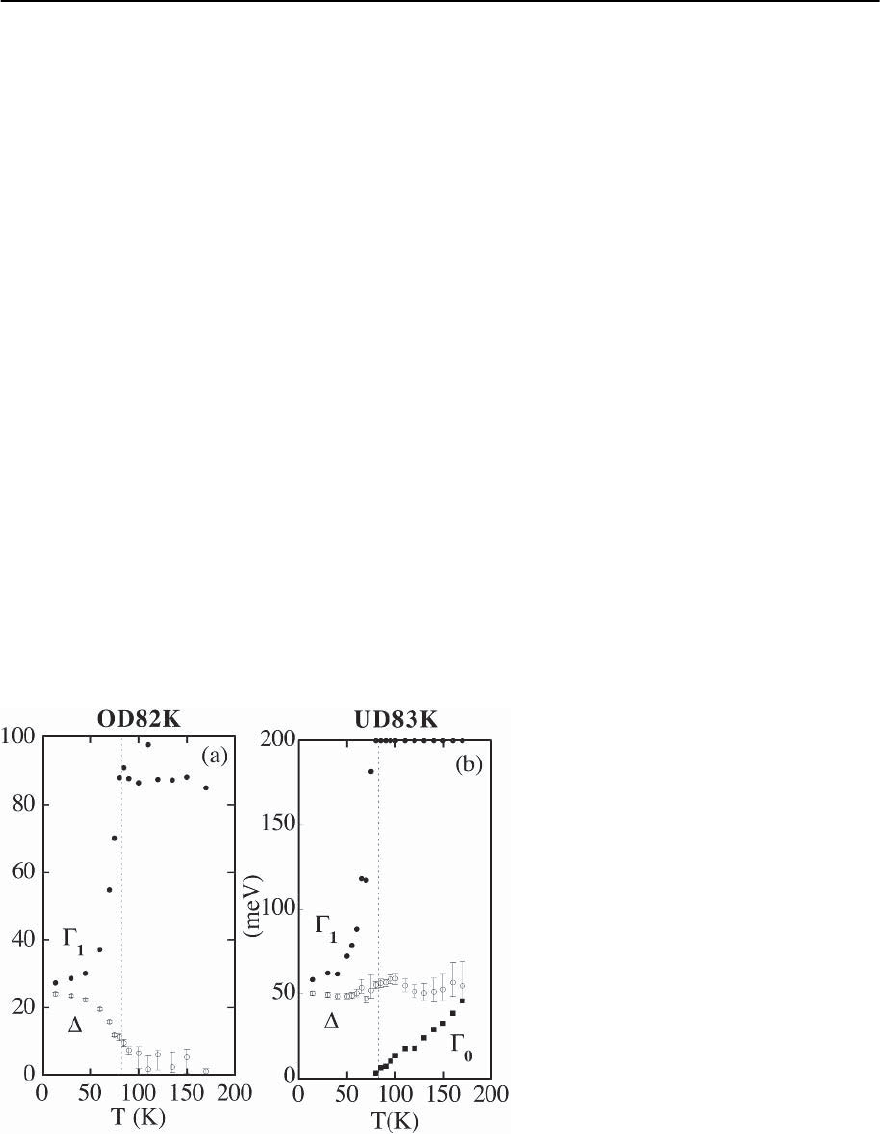
17 Photoemission in the High-T
c
Superconductors 969
convolve it with the experimental resolution, and fit
to symmetrized data.The fit is restricted to a range of
±45 meV given the small gap in the overdoped case
and the sharpness of the quasiparticle peaks below
T
c
. We find that Eq. (17.15) describes the low energy
data quite well.
The T-variation of the fit parameters and
1
are
shown in Fig. 17.41(a). (T) decreases with T,and
although small at T
c
,itonlyvanishesaboveT
c
,indi-
cating the possibility of a weak pseudogap.This effect
is sample dependent, in that several overdoped sam-
ples we have looked at, the gap vanishes closer to T
c
.
We caution that the error bars shown in Fig. 17.41(a)
are based on the RMS error of the fits,butdo not take
into account experimental errors in and k
F
.
1
(T) is found to be relatively T-independent in
the normal state. Below T
c
,weseethat
1
decreases
very rapidly, and can be perfectly fit to the form
a + bT
6
. This rapid drop in linewidth leading to
sharp quasiparticle peaks at low T, which can be
seen directly in the ARPES data, is consistent with
microwave and thermal conductivity measurements,
and implies that electron-electron interactions are
responsible for
1
. Note the clear break in
1
at T
c
,de-
spite the fact has not quite vanished. We have seen
similar behavior to that described above for a variety
of overdoped samples at several k points.
We next turn to the more interesting underdoped
case. We find that near (, 0) the self-energy equa-
tion (17.15) cannot give an adequate description of
the data, in that it does not properly describe the
pseudogapanditsunusual“filling in”aboveT
c
.Theo-
retically,we cannot have a divergence in £(k
F
, ! =0)
in a state without broken symmetry. A simple mod-
ification of the BCS self-energy rectifies both these
problems:
£(k, !)=−i
1
+
2
/[! + (k)+i
0
] . (17.17)
The new term
0
(T)shouldbeviewedasthein-
verse pair lifetime. The theoretical motivation for
Eq. (17.17) is given in [108].We stress that this three
parameter form is again a minimal representation of
the pseudogap self-energy. Since it is not obviously
a unique representation, it is very important to see
what one learns from the fits.
In Fig. 17.40(b), we show symmetrized data at the
antinode for a T
c
= 83 K underdoped sample. Be-
low T
c
we see quasiparticle peaks. Above T
c
these
peaks disappear but there is still a large suppression
of spectral weight around !=0.As T is raised further,
the pseudogap fills in (rather than closing) leading
to a flat spectrum at a temperature of T
∗
(200K).The
self-energy, Eq. (17.17), gives a good fit to the data.
These fits were done below T
c
over a larger energy
Fig. 17.41. (open circles),
1
(solid circles), and
0
(solid squares)versusT at the ( , 0)−(, )
Fermi crossing for (a)aT
c
=82Koverdoped
sample and (b)aT
c
=83Kunderdopedsam-
ple. The dashed line marks T
c
.Theerrorbars
for are based on a 10% increase in the RMS
error of the fits
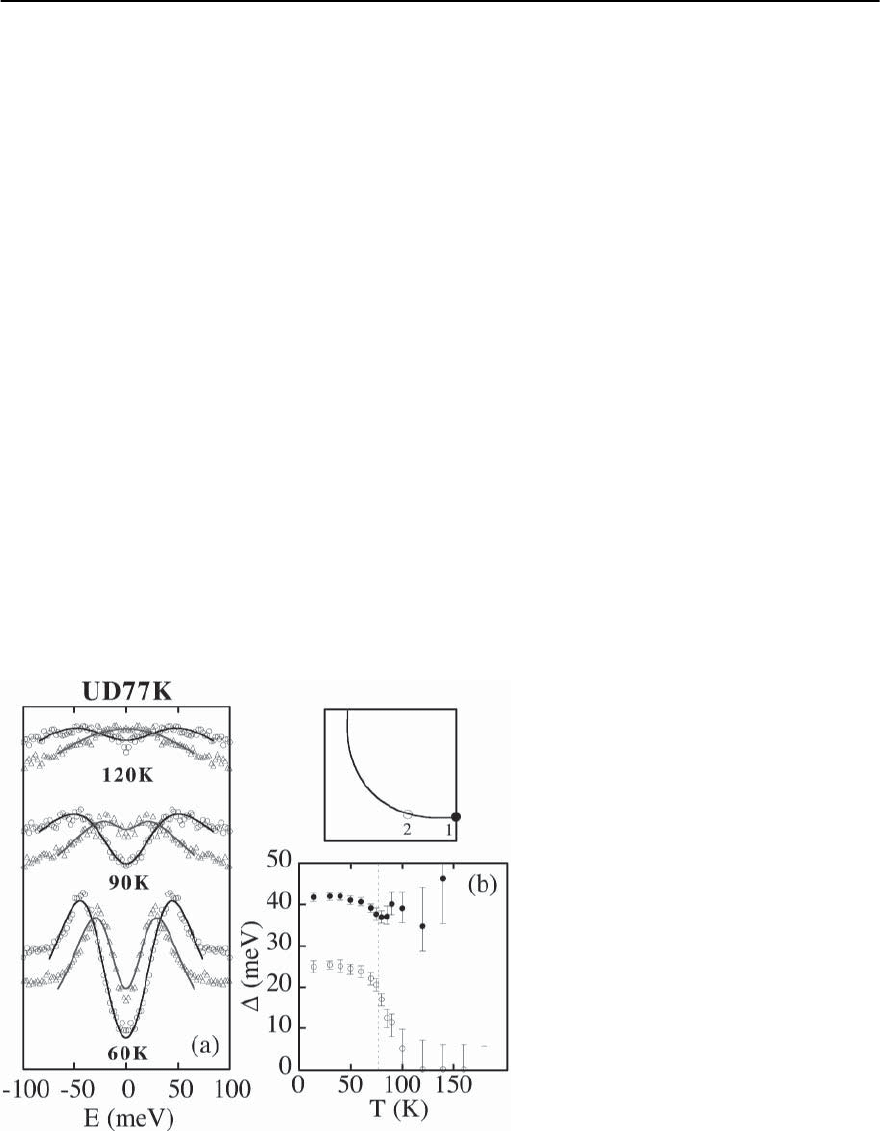
970 J.C. Campuzano, M.R. Norman, and M. Randeria
range (±75 meV) than in the overdoped case because
of the larger gap. The range above T
c
was increased
to ±85 meV so as to properly describe the pseudogap
depression.
In Fig.17.41(b), we show the T-dependence of the
fit parameters. We find a number of surprises. First,
is independent of T within error bars. Similar be-
havior has been inferred from specific heat and tun-
neling data. This T-independence is in contrast to
the behavior of the overdoped 82 K sample with al-
most identical T
c
at the same k point. In addition, for
the underdoped sample, the gap evolves smoothly
through T
c
.
The single-particle scattering rate
1
(T) for the
underdoped sample is found to be qualitatively sim-
ilar to the overdoped case. It is consistent with being
T-independent above T
c
, but with a value over twice
as large as the overdoped case (allowing
1
to vary
above T
c
does not improve the RMS error of the fits).
Second,we see the same rapid decrease in
1
belowT
c
as in the overdoped case. Note again the clear break
at T
c
.
The most interesting result is
0
(T).We find
0
=0
below T
c
and proportional to T − T
c
above. This be-
havior isrobust,and is seen inall the fits that we have
tried. Moreover, a non-zero
0
is needed above T
c
to
obtain a proper fit to the data (its effect cannot be re-
produced by varying the other parameters). The fact
that this T-dependence is exactly what one expects of
an inverse pair lifetime is a non-trivial check on the
validity of the physics underlying Eq. (17.17). Fur-
ther, we observe from Fig. 17.41 that T
∗
corresponds
to where (T) ∼
0
(T).This condition canbe under-
stood from the small ! expansion of Eq. (17.17).
The next important question is whether the T-
dependence at the antinode described above exists
at other k
F
-points. To answer this, we have looked at
T-dependent data for a number of underdoped sam-
plesat two differentk vectors.All data at the antinode
give results similar to those forthe 83K sample.How-
ever atthe second k-point,about halfwaybetween the
antinode and the node along the (0, 0)−(, )direc-
tion, we see quite different behavior.We demonstrate
this in Fig. 17.42(a) where symmetrized data for a
77 K underdoped sample are shown. For the antin-
ode,one clearly sees the gap fill in above T
c
,withlittle
evidence for any T-dependence of the position of the
spectral feature defining the gap edge, just as for the
83K sample.In contrast,at the second k point,the gap
is clearly closing, indicating a strong T-dependence
of . Similar behavior is seen in other underdoped
samples with T
c
between 75 K and 85 K.
Fig. 17.42. (a) Symmetrized data for a T
c
=77K
underdoped sample for three temperatures at
(open circles) k
F
point 1 in the zone inset,and
at (open triangles) k
F
point 2, compared to the
model fits.(b) (T)forthesetwok points (filled
and open circles), with T
c
marked by the dashed
line
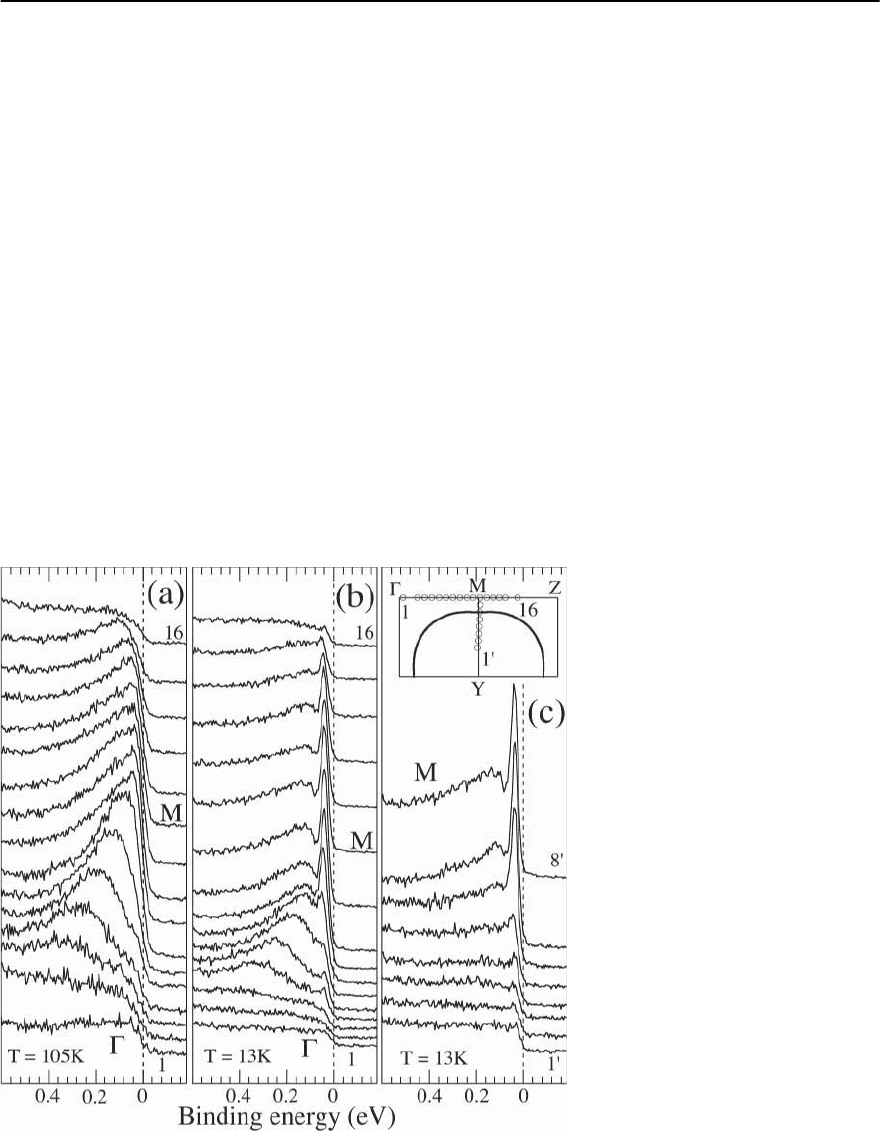
17 Photoemission in the High-T
c
Superconductors 971
In Fig. 17.42(b), we show the T-dependence of
obtained from fits (over a range of ±66 meV) at the
second k point for the 77 K sample. is found to be
strongly T-dependent, being roughly constant below
T
c
,then dropping smoothly to zero above.The strong
T-dependence of makes it difficult to unambigu-
ously determine
0
from the fits at this k-point. On
theoretical grounds, we expect that, here too, there
is a non-zero
0
, and the closing of the pseudogap
is again determined by (T) ∼
0
(T), however this
condition issatisfiedbytherapiddropin (T),rather
than the rise in
0
(T).For completeness,we also show
(T) for this sample at the antinode,whichhasa sim-
ilar behavior to that of the 83 K sample.
We see that these results give further evidence
for the unusual k-dependences first noted in [90].
Strong pairing correlations are seen over a very wide
T-range near (, 0), but these effects are less pro-
nounced and persist over a smaller T-range as one
moves closer to the zone diagonal.This is clearly tied
to the strong k-dependence of the effective interac-
tion and the unusual (anomalously broad and non-
dispersive) nature of electronic states near (, 0).
17.7.4 Peak/Dip/Hump– Experiment
We now turn to a detailed discussion of the
peak/dip/hump lineshape. As mentioned above, a
very broad normal state spectrum near the (, 0)
point of the zone evolves quite rapidly for T < T
c
into a narrow quasiparticle peak, followed at higher
binding energies by a dip then a hump, the latter
corresponding to where the spectrum recovers to its
normal state value [109].Similar effects areobserved
in tunneling spectra [110].
In Fig. 17.43, we show spectra for a T
c
=87K
Bi2212 sample along −
¯
M − Z, i.e., (0, 0) − (, 0) −
(2, 0),in (a) the normal state (105 K) and (b) the su-
perconducting state (13 K), from which we note two
striking features [58]. First, we see that the low en-
ergy peak in the superconducting state persists over
a large range in k-space, even when the normal state
Fig. 17.43. Spectra in (a)thenormal
state (105 K) and (b) the superconduct-
ing state (13 K) along the line −
¯
M −
Z,and(c) the superconducting state
(13K)alongtheline
¯
M − Y for an over-
doped (T
c
= 87 K) Bi2212 sample. The
zone is shown as an inset in (c)withthe
curved line representing the observed
Fermi surface

972 J.C. Campuzano, M.R. Norman, and M. Randeria
spectra have dispersed away from the Fermi energy.
Second, when the hump in the superconducting state
disperses, it essentially follows that of the normal
state spectrum. This is accompanied by a transfer of
weight to the hump from the low frequency peak,
which is fairly fixed in energy.The same phenomena
are also seen along
¯
M to Y (Fig. 17.43(c)). We will
argue that the unusual dispersion seen in the super-
conducting state of Fig. 17.43 is closely tied to the
lineshape change discussed earlier (Fig. 17.38).
The simplest explanation of the superconducting
state spectra would be the presence of two bands
(e.g., due to bilayer splitting), one responsible for the
peak and the other for the hump. However, this ex-
planation is untenable. (Bilayer splitting is discussed
in Sect. 17.4.5.) First, if the sharp peak were associ-
ated with a second band, then this band should also
appear above T
c
.But there is no evidence for it in the
normal state data.Second, if the peak and hump were
from two different bands, then their intensities must
be governed by different matrix elements. However,
we found [36] that the intensities of both features
scaled together as the photon polarization was varied
from in to out of plane, as if they were governed by a
common matrix element (Section 5.4.5).These argu-
ments suggest that the unusual lineshape and disper-
sion represent a single electronic state governed by
non-trivial many-body effects,asassumedin the pre-
vious discussion (Figs. 17.36–17.39).For more over-
doped materials, though, bilayer splitting should be
taken into account, as discussed in Sect. 17.4.5.
Under this assumption, the data are consistent
with a strong reduction of the imaginary part of
the self-energy (Im£) at low energies in the su-
perconducting state (Fig. 17.36). If the scattering is
electron–electron likein nature,then Im£ at frequen-
cies smaller than ∼ 3 will be suppressed due to the
opening of the superconducting gap [111].On closer
inspection,though,a more interesting story emerges.
First, from Figs. 17.36 and 17.43, we see that the su-
perconducting and normal state data match beyond
90 meV. From 90 meV, the dip is quickly reached at
70 meV, then one rises to the sharp peak. Notice that
since the width of the peak is around 20 meV, then
thechangeinbehaviorofthespectra(fromhump,to
dip, to the trailing edge of the peak) is occurring on
the scale of the energy resolution. That means that
the intrinsic dip must be quite sharp. This implies
that the large Im£ at high energies must drop to a
small value over a narrow energy interval to be con-
sistent with the data, i.e., there is essentially a step in
Im£. In fact, the data are not only consistent with a
step in Im£, but the depth of the dip is such that it is
best fit by a peak in Im£ at the dip energy, followed
byarapiddroptoasmallvalue.Thisbehaviorcan
again be seen from the independent analysis shown
in Figs. 17.36 and 17.39.
What are the consequences of this behavior in
Im£?IfIm£ hasasharpdropat ˜!, then by Kramers–
Kronig transformation, Re£ will have a sharp peak
at ˜! (Fig. 17.36). This peak can very simply explain
the unusual dispersion shown in Fig. 17.43, as it will
cause a low energy quasiparticle pole to appear even
if the normal state binding energy is large. The most
transparent way to appreciate this result is to note
that a sharp step in Im£ is equivalent to the prob-
lem of an electron interacting with a sharp (disper-
sionless) mode, since in that case, the mode makes
no contribution to Im£ for energies below the mode
energy, and then makes a constant contribution for
energies above. This problem has been treated by
Engelsberg and Schrieffer [112], and extended to
the superconducting state by Scalapino and cowork-
ers [113].The difference in our case is that since the
effect only occurs below T
c
, it is a consequence of
the opening of the superconducting gap in the elec-
tronic energy spectrum, and thus of a collective ori-
gin, rather than a phonon.
To facilitate comparison to this classic work, in
Fig.17.44 we plot the position of the low energy peak
and higher bindingenergy hump as a functionof the
energy of the single broad peak in the normal state.
This plot has a striking resemblance to that predicted
for electrons interacting with a sharp mode in the
superconducting state, and one clearly sees the low
energy pole which we associate with the peak in Re£.
On general grounds,the flat dispersion of the low en-
ergy peak seen in Fig. 17.44 is a combination of two
effects: (1) the peak in Re£, which provides an ad-
ditional mass renormalization of the superconduct-
ing state relative to the normal state, and thus pushes
spectral weight towards the Fermi energy,and (2) the
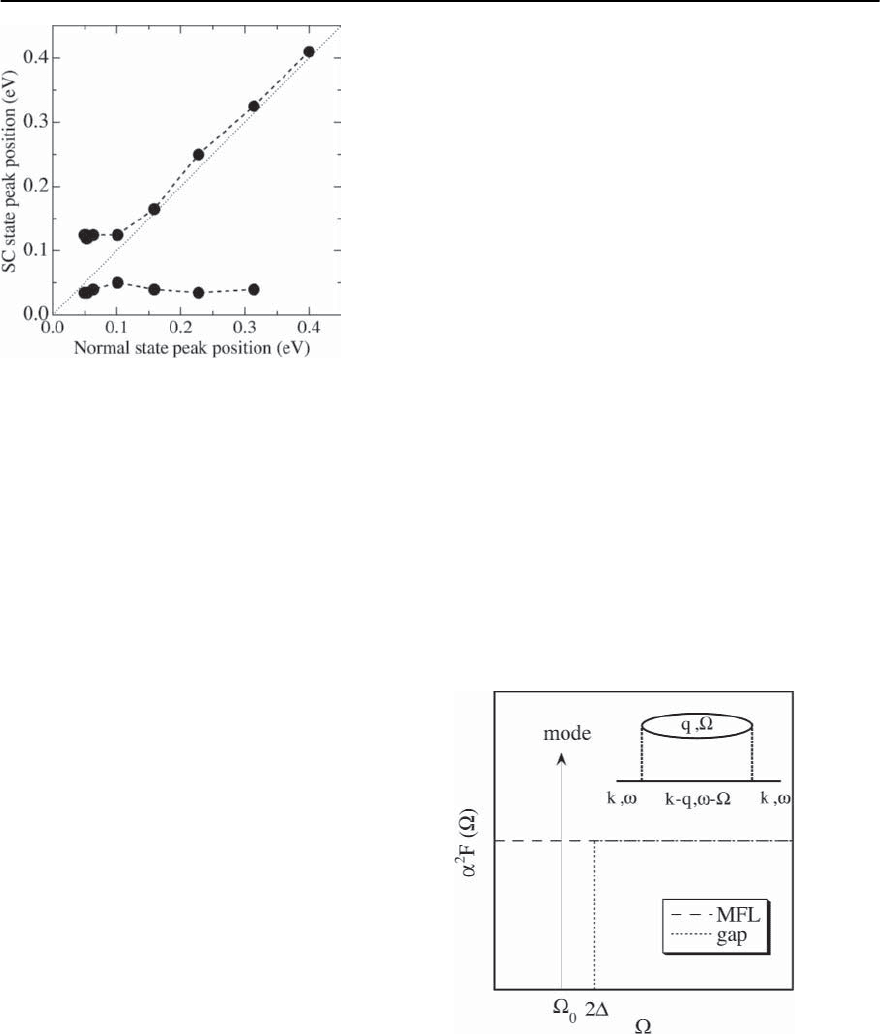
17 Photoemission in the High-T
c
Superconductors 973
Fig. 17.44. Positions of the sharp peak and the broad hump
in the superconducting stateversusnormalstatepeak posi-
tion obtained from Figs.17.43(a) and 17.43(b).Solid points
connected by a dashed line are the data, the dotted line
represents the normal state dispersion
superconducting gap, which pushes spectral weight
away. This also explains the strong drop in intensity
of the low energy peak as the higher binding energy
hump disperses.
An important feature of the data is the dispersion-
less nature of the sharp peak. The mode picture dis-
cussed above would imply a dispersion of the peak
from
k
to ˜! = !
0
+
k
as the normal state bind-
ing energy increases (where !
0
isthemodeenergy).
However, this dispersion turns out to be weak. From
the data of Fig. 17.36, we infer an !
0
=1.3
max
, !
0
being essentially the energy separation of the peak
and dip. Since
k
is known to be of the d
x
2
−y
2
form,
then
k
should go to zero as we disperse towards the
point. Therefore, the predicted dispersion is only
from
max
to 1.3
max
(32 meV to 42 meV).
Since the dip/hump structure is most apparent at
the (, 0) points, it is natural to assume that it has
somethingtodowithQ =(, ) scattering, as dis-
cussed by Shen and Schrieffer [114].But here,we find
aneweffect.If onecompares thedata of Figs.17.43(b)
and 17.43(c),one sees that a low energy peak also ex-
ists along (, 0) − (, ) for approximately the same
momentum range as the one from (, 0) − (0, 0).
That is, if there is a peak for momentum p ,onealso
exists for momentum p + Q.This can be understood,
since the self-energy equations for p and p + Q will
be strongly coupled if Q scattering is dominant.
17.7.5 Mode Model
For now, we ignore the complication of momen-
tum dependence. The lowest order contribution to
electron–electron scattering is represented by the
Feynman diagram shown in the inset of Fig.17.45.In
the superconducting state, each internal line will be
gapped by . This implies that the scattering will be
suppressed for |!| < 3. This explains the presence
of a sharp quasiparticle peak at low temperatures.
What is not so obvious is whether this in addition
explains the strong spectral dip.Explicit calculations
show only a weak dip-like feature [115]. To under-
stand this in detail, we equate the bubble plus inter-
action lines (Fig. 17.45,inset) to an “˛
2
F”asinstan-
dard strong-coupling literature. In a marginal Fermi
liquid (MFL) at T=0, ˛
2
F(§) is simply a constant in
§. The effect of the gap is to force ˛
2
F to zero for
§ < 2. The question then arises where the gapped
weight goes. It could be distributed to higher ener-
gies, but in light of the above discussion, we might
expect it to appear as a collective mode inside of the
2 gap. For instance, if the bubble represents spin
Fig. 17.45. ˛
2
F for three models, MFL (dashed line), gapped
MFL (dotted line), and gapped MFL plus mode (dotted line
plus ı function). Inset: Feynman diagram for the lowest
order contribution to £ from electron–electron scattering
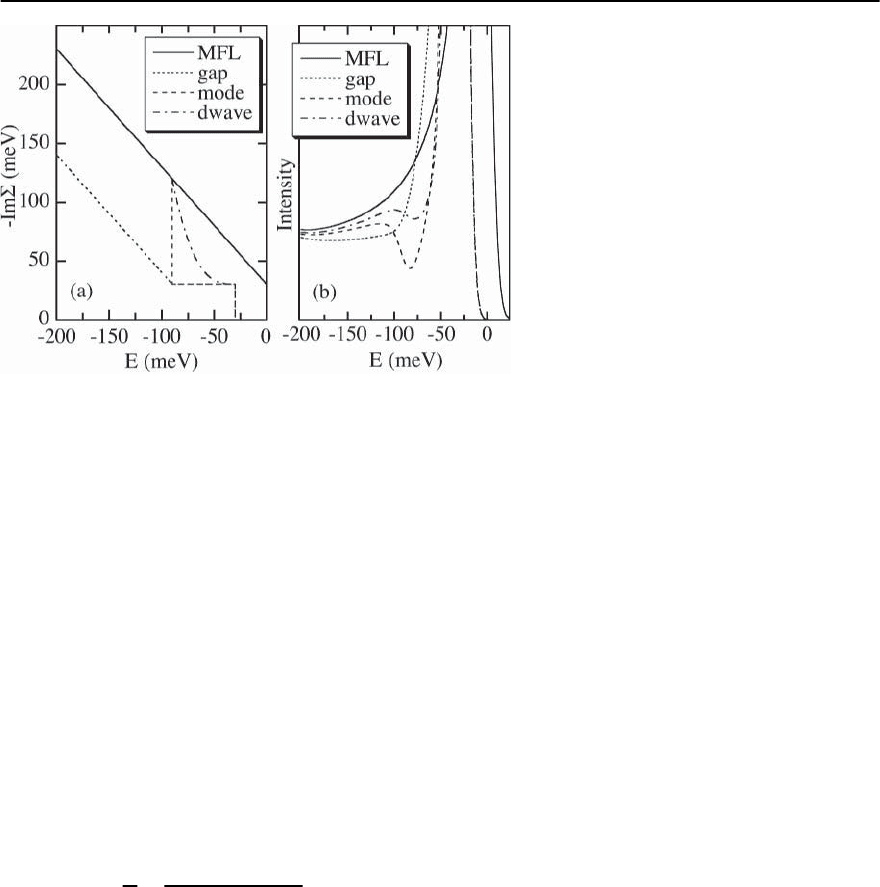
974 J.C. Campuzano, M.R. Norman, and M. Randeria
Fig. 17.46. (a)Im£ for MFL (solid line),
gapped MFL (dotted line), gapped MFL plus
mode (dashed line), and simple d-wave model
(dashed-dotted line). Parameters are ˛=1,!
c
=
200 meV, = 30 meV (0 for MFL), §
0
= Delta,
and
0
=30meV.(b) Spectral functions (times a
Fermi function with T = 14 K) convolved with
a resolution Gaussian of =7.5meVforthese
four cases ( =-34meV)
fluctuations, a sharp mode will appear if the con-
dition 1 − U
0
(q, §) = 0 is satisfied for § < 2.
These three cases (MFL, gapped MFL, gapped MFL
plus mode) are illustrated in Fig. 17.45.
£ is easy to obtain analytically if we ignore
the complication of the superconducting density of
states from the k −q line of Fig.17.45 and just replace
this by a step function at .TheresultingIm£ for the
gapped MFL and gapped MFL plus mode models are
shown in Fig. 17.46(a) [116] in comparison to the
normalstateMFL.Notethatstructurein˛
2
F at §
appears in £ at |!| = § + due to the gap in the
k − q line. Moreover, the MFL plus mode is simply
the normal state MFL cutoff at 3 (this is obtained
under the assumption that all the gapped weight in
˛
2
F shows up in the mode). In contrast, the gapped
MFL decays linearly to zero at 3.
The Nambu spectral function is given by
A(!)=
1
Im
Z! +
Z
2
(!
2
−
2
)−
2
, (17.18)
with (a complex) Z(!)=1−£(!)/!.Theseare
shown in Fig. 17.46(b) and were convolved with a
gaussian of =7.5 meV, typical of high resolution
ARPES,with a constantIm£ (
0
) added for |!| > to
reducethe size of the quasiparticle peak.Wenote that
there is no dip as such for the gapped MFL model,
whereas the addition of the mode causes a signifi-
cant dip.The latter behavior is consistent with exper-
iment. Moreover, the mode model has the additional
advantage that Im£ recovers back to the normal state
value by 3, which is also in agreement with exper-
iment in that the normal and superconducting state
spectra agree beyond 90 meV (Figs.17.36 and 17.43).
We contrast this behavior with that expected for a
simple d-wavemodel.Toafirstapproximation,this
can be obtained by replacing the step drop in Im£
in the MFL plus mode model with (|!| − )
3
for
|!| < 3 [117].This is shown in Fig.17.46(a) as well,
with the resulting spectrum in Fig. 17.46(b). Only a
weak dip appears. Moreover, we have analyzed mod-
els with the exponent 3 replaced by some n and have
found that n must be large to obtain a dip as strong
as seen in experiment. Therefore, the upshot is that
at the least, something similar to a step is required in
Im£ to be consistent with experiment.
In principle, we could take the above MFL plus
mode model and fit experiment with it. We consider
a simpler model. There are several reasons for this.
First, the MFL model has a number of adjustable
parameters associated with it. There is the coupling
constant (˛),thecutoff frequency (!
c
),andthemode
energy (which is not in general 2). Moreover, the
spectrum for k points near the (, 0) point does not
appear to be MFL-like in nature. We have found that
the normal state Bi2212 spectrum is fit very well by a
Lorentzian plus a constant background in an energy
range less than 0.5 eV. This is also true for Bi2201
spectrum where the normal state can be accessed to
much lower temperatures.
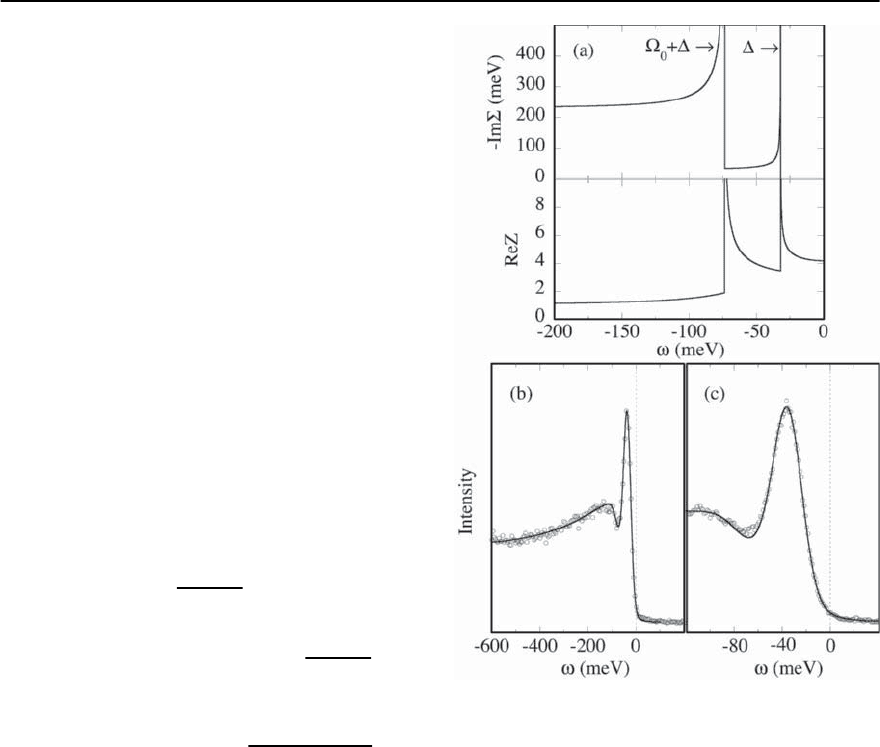
17 Photoemission in the High-T
c
Superconductors 975
In the resulting Lorentzian model, the normal
state £ is purely an imaginary constant, and ˛
2
F is
a mode at zero energy. In the superconducting state,
this mode gets pushed back to some energy within
2. This model is artificial in the sense that all the
self-energy is being generated by the mode. That
is why we went through the above discussion mo-
tivating the mode more properly as a rearrangement
of ˛
2
F due to the superconducting gap. In practice,
though, the results are very similar to the MFL plus
mode model, and has the further advantage of hav-
ing the several parameters of that model collapse to
just the mode strength (
1
)andmodeposition(§
0
)
of the Lorentzian model. Moreover, analytic results
can still be obtained for £ when the superconducting
density of states for the k −q line of Fig.17.45is taken
into account. The result is [116]
−Im£(!)=
0
N(|!|)+
1
N(|!| − §
0
),
|!| > §
0
+
=
0
N(|!|), < |!| < §
0
+
=0, |!| < , (17.19)
where N(!)=!/
√
!
2
−
2
is the BCS density of
states, and
Re£(!)=
0
N(−!)ln
| − ! +
√
!
2
−
2
|/
+
1
N(§
0
− !)ln
|§
0
− !
+
(! − §
0
)
2
−
2
|/
− {! → −!} . (17.20)
Here, it has again been assumed that is a real con-
stant in frequency. An s-wave density of states has
been used to obtain an analytic result.A d-wave den-
sity of states will not be that different. The advantage
of an analytic result is that it is useful when having
to take spectra and convolve with resolution to com-
pare to experiment.Our results are not very sensitive
to
0
, included again to damp the quasiparticle peak.
The resulting real (Eq. (17.20)) and imaginary
(Eq. (17.19)) parts of £ at (, 0) are shown in
Fig. 17.47(a). Note the singular behaviors at (peak
energy) due to the
0
term and at §
0
+ (dip en-
ergy) due to the
1
term. In both cases, step drops in
Fig. 17.47. (a)Im£ and ReZ at ( , 0) from Eqs. 17.19 and
17.20 (
1
= 200 meV,
0
=30meV, =32meV,§
0
=1.3).
Comparison of the data at (, 0) for (b)wideand(c)nar-
row energy scans with calculations based on Eqs. 17.18–
17.20, with an added step edge background contribution
Im£ would also give singularities in Re£.Theadvan-
tage of peaks in Im£ (due to the SC density of states)
is that it makes the dip deeper in better agreement
with experiment. In Figs. 17.47(b) and 17.47(c), we
show a comparison of the resulting spectral function
(convolved with the experimental energy and mo-
mentum resolution) to experimental data at (, 0)
for both wide and narrow energy scans, where a step
edge background with a gap of is added to the
calculated spectrum. The resulting agreement is ex-
cellent.
It is interesting to note that the mode energy
we infer from the data is 41 meV, equivalent to a
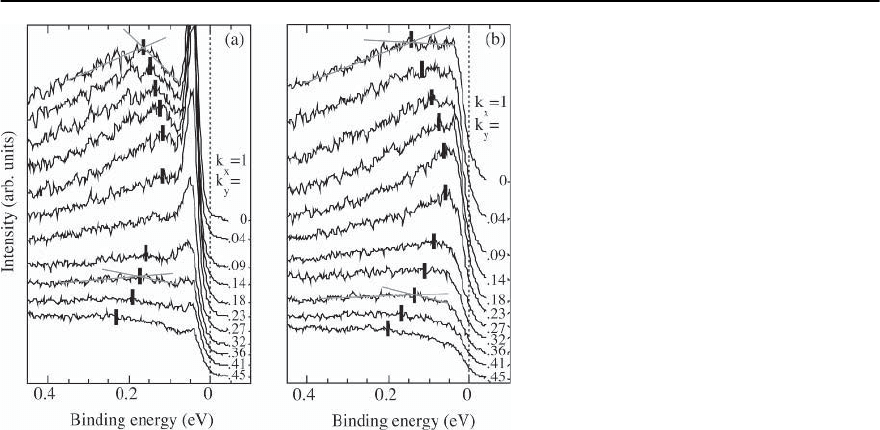
976 J.C. Campuzano, M.R. Norman, and M. Randeria
Fig. 17.48. Spectra along ( , 0) → (, )in(a)
the superconducting state (T =60K),and(b)
the pseudogap state (T = 100 K) for an under-
doped 75 K sample (curves are labeled in units
of /a). The thick vertical bar indicates the po-
sition of the higher energy feature,at which the
spectrum changes slope as highlighted by the
intersecting straight lines
magnetic resonant mode energy observed in YBCO
[118] and Bi2212 [119] by neutron scattering data at
Q =(, ). The Q dependence of this mode cor-
relates well with the observations of Fig. 17.43. To
explore this in greater detail, we now consider the
doping dependence of the peak/dip/hump structure.
17.7.6 Doping Dependence
We show data along (, 0) → (, ) for an un-
derdoped 75 K sample in the superconducting
state (Fig. 17.48(a)) and in the pseudogap state
(Fig. 17.48(b)) [59]. Below T
c
,thesharppeakatlow
energy is essentially dispersionless, while the higher
energy hump rapidly disperses from the (, 0) point
towards the (, 0) → (, ) Fermi crossing seen
above T
∗
. Beyond this, the intensity drops dramat-
ically, but there is clear evidence that the hump dis-
perses back to higher energy. In the pseudogap state,
the high energy feature also shows strong dispersion,
much like the hump below T
c
, even though the lead-
ing edge is non-dispersive like the sharp peak in the
superconducting state.
In Fig. 17.49 we show the dispersion of the sharp
peak and hump (below T
c
), for a variety of doping
levels, in the vicinity of the (, 0) point along the
two principal axes. The sharp peak at low energies is
seen to be essentially non-dispersive along both di-
rections for all doping levels, while the hump shows
very interesting dispersion. Along (, 0) → (0, 0)
(Fig. 17.49(a)), the hump exhibits a maximum, with
an eventual dispersion away from the Fermi energy,
becoming rapidly equivalent to the binding energy
of the broad peak in the normal state as one moves
away from the region near (, 0). In the orthogonal
direction (Fig. 17.49(b)),sincethe hump initiallydis-
perses towards the (, 0) → (, ) Fermi crossing,
which is known to be a weak function of doping,one
obtains the rather dramatic effect that the dispersion
becomes stronger with underdoping. We also note
that there is an energy separation between the peak
and the hump due to the spectral dip. In essence, the
hump disperses towards the spectral dip, but cannot
cross it, with its weight dropping strongly as the dip
energy is approached. Beyond this point, one sees
evidence of the dispersion bending back to higher
binding energy for more underdoped samples.
Fig. 17.50(a) shows the evolution of the low tem-
perature spectra at the (, 0) point as a function
of doping. The sharp quasiparticle peak moves to
higher energy, indicating that the gap increases with
underdoping (although this is difficult to see on the
scale of Fig. 17.50(a)). We see that the hump moves
rapidly to higher energy with underdoping. These
trends can be seen very clearly in Fig. 17.50(b), where
theenergy of thepeak andhumpare shown asa func-
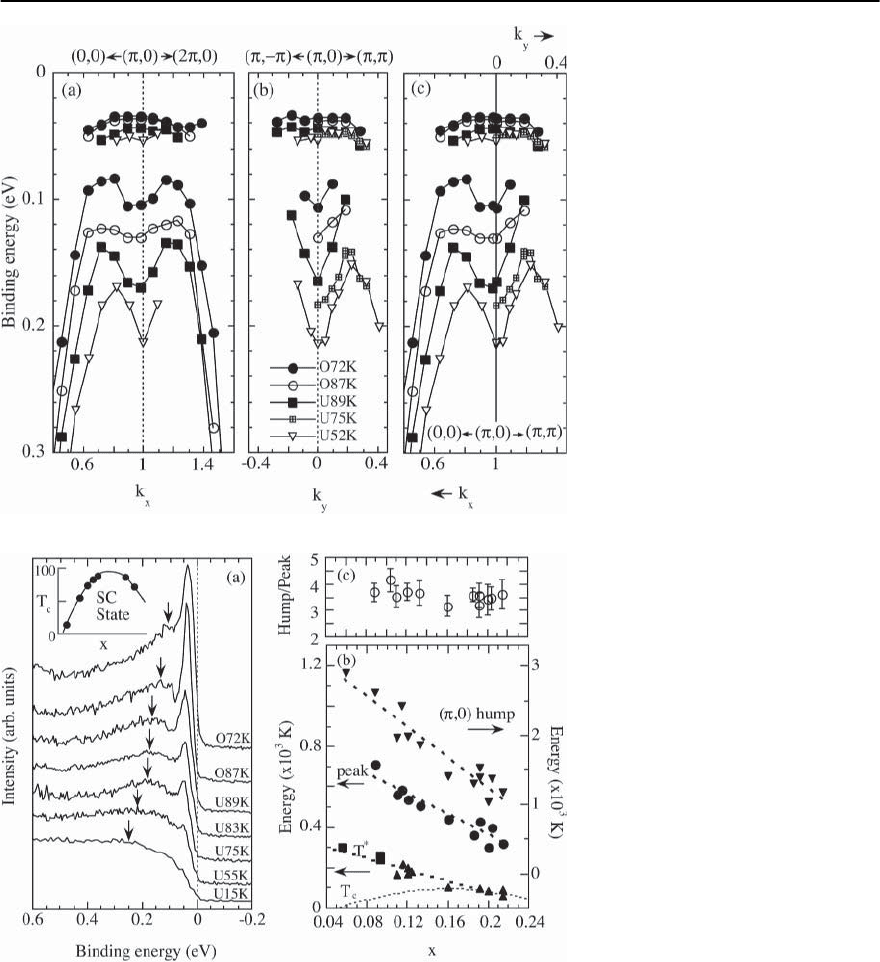
17 Photoemission in the High-T
c
Superconductors 977
Fig. 17.49. Doping dependence of the
dispersion from (a)(, 0) → ( ±
, 0). (b)( , 0) → ( , ± ), and (c)
both directions, for the peak and hump
in the superconducting state. U is un-
derdoped and O is overdoped. Points
were obtained by polynomial fits to the
data and are consistentwith the simpler
criterion used in Fig. 17.48
Fig. 17.50. Dependence of energy scale
on carrier density. (a) Doping depen-
dence of the spectra (T =15K)atthe
(, 0) point.The inset shows T
c
vs.dop-
ing. (b) Doping dependence of T
∗
,and
the peak and hump binding energies
in the superconducting state along with
theirratio (c),as a function of doping,x.
The empirical relation between T
c
and x
is given by T
c
/T
max
c
=1−82.6(x−0.16)
2
with T
max
c
=95K.ForT
∗
solid squares
represent lower bounds
tion of doping for a large number of samples. Finally,
we observe that the quasiparticle peak loses spectral
weight with increasing underdoping, as expected for
a doped Mott insulator; in addition the hump also
loses spectral weight though less rapidly.
This effect has recently been quantified in greater
detail, where it was found that the spectral weight of
the peak varies linearly with doping, as reproduced
in Fig. 17.51. [92,93].We remark that Ding et al. [93]
also found the unusual relation that the product of

978 J.C. Campuzano, M.R. Norman, and M. Randeria
Fig. 17.51. (a) Doping dependence of
the low-T (14 K) coherent weight (z
A
).
The dashed line is a guideline showing
that z
A
increases linearly on the under-
doped side and tapers off on the over-
doped side (from [93]). (b) The dop-
ing dependence of the superconducting
peak ratio (SPR) is plotted over a typi-
calBi2212 phase diagram.The solid line
is a guide to the eye. Horizontal error
bars denote uncertainty in determin-
ing the doping level (±0.01); vertical
error bars denote uncertainty in deter-
mining the SPR (±1.5%).AF: antiferro-
magnetic regime. SC: superconducting
regime (from [92])
the peak weight times the peak energy is constant
with doping.
The hump below T
c
is clearly related to the super-
conducting gap, given the weak doping dependence
of the ratio between thehump andquasiparticle peak
positions at (, 0), shown in Fig. 17.50(c). Tunneling
data find this same correlation on a wide variety of
high-T
c
materialswhose energy gaps vary by a factor
of 30 [60].
To motivate the analysis below that firmly estab-
lishes the mode interpretation of the peak/dip/hump
spectra anditsconnectionwithneutrondata,wenote
that the spectral dip represents a pairing induced
gap in the incoherent part of the spectral function
at (, 0) occurring at an energy + §
0
,where is
the superconducting gap and §
0
isthemodeenergy.
We can estimate the mode energy from ARPES data
from the energy difference between the dip ( + §
0
)
and the quasiparticle peak ().
In Fig. 17.52(b) we plot the mode energy as es-
timated from ARPES for various doping levels as a
function of T
c
and compare it with neutron mea-
surements.We find striking agreement both in terms
of the energy scale and its doping dependence.(Neu-
tron results are reviewed by P. Bourges [120] and by
Hayden, Chap. 18 in this volume.) The same agree-
ment, in greater detail, has been recently found us-
ing tunneling data [121], as shown in Fig. 17.53. We
note that the mode energy inferred from ARPES de-
creases with underdoping, just like the neutron data,
unlike thegap energy (Fig.17.50(b)),whichincreases.
This can be seen directly in the raw data, shown in
Fig. 17.52(a). This is also seen from the tunneling
data, where they have found that the mode energy
scales with doping as 5T
c
, just like the neutron reso-
nance.An interesting point from the tunneling is that
the ratio of the mode energy to the gap energy satu-
ratesto 2 in the overdopedlimit,aswould beexpected
for a collective mode sitting below a continuum with
agapof2. Moreover, there is strong correlation be-
tween the temperature dependences in the ARPES
and neutron data. While neutrons see a sharp mode
only below T
c
, a smeared out remnant persists up to
T
∗
[122].As the sharpness of the mode is responsible
for the sharp spectral dip, one then sees the correla-
tion with ARPES where the dip disappears above T
c
,
but with a remnant of the hump persisting to T
∗
.
An important feature of the neutron data is that
the mode only exists in a narrow momentum range
about (, ), and is magnetic in origin. To see a fur-
ther connection withARPES,we return to the results
of Fig. 17.49. Note the dispersion along the two or-
thogonal directions are similar (Fig. 17.49(c)), un-
like the dispersion inferred in the normal state. As
